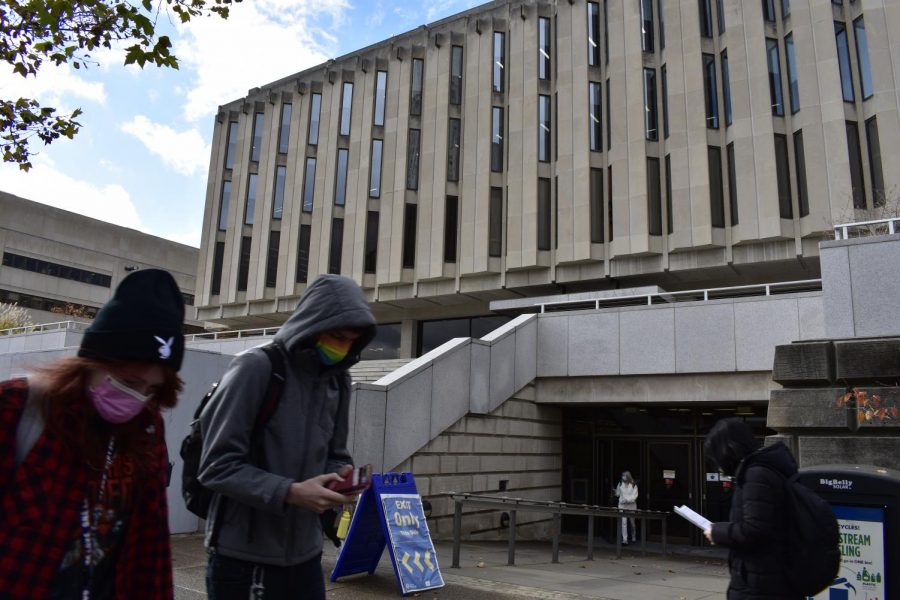Pitt Archives document many areas of western Pennsylvania history
Romita Das | Senior Staff Photographer
Students walk by the Hillman Library.
November 17, 2021
From 18th-century handwritten documents by George Washington to a complete set of John James Audubon’s “Birds of America,” Pitt’s Archives and Special Collections has thousands of valuable items documenting western Pennsylvania history.
“We have somewhere in the neighborhood of 1,200 different archival collections,” Ed Galloway, associate University librarian for Archives and Special Collections, said. “Some of those range from a box, some of those range up to 500 or 1,000 boxes, it all depends on the collection.”
Pitt’s Archives and Special Collections are located on the third floor of Hillman Library and open to Pitt students, researchers and members of the public as long as they have a valid ID and schedule an appointment. The collections range across a wide variety of topics that document the work of different organizations, individuals and businesses.
Besides its physical Hillman location, the University Library System has a digital collections webpage where some collections can be viewed. Galloway said a very “small percentage” of the collections are available digitally, but ULS is working to upload more. Some documents available digitally include several hundred 19th- and 20th-century theatre programs and photographs from early Pitt theatre.
“We have three full-time technicians who do nothing but scan, do quality control and other related tasks,” Galloway said. “That’s amazing, three full-time, and yet it’s still nowhere near what we have physically, just because of how long it takes to scan and do that type of work.”
Galloway said the “vast majority” of collections are donated, although ULS has the ability to purchase items or collections that are within its budget. ULS recently acquired the George Romero collection, which Galloway said caused ULS to start collecting “as much as they can” surrounding horror. The August Wilson collection is another recent acquisition ULS has had for a little more than a year.
“They come to us through families, estates, building relationships with people, often businesses that go defunct or organizations that no longer exist,” Galloway said. “In some cases, if we really want a whole collection or just a rare book being sold at an auction, we have to buy it.”
Megan Massanelli, an engagement and outreach librarian with Archives and Special Collections, said archive faculty members work with Pitt professors to determine if there are any materials they have on hand that may aid in class instruction. Massanelli said they work with “anywhere between 30 and 40” classes each semester.
“We recently worked with an English composition class focused on the narratives of doctors, doctoring in history and popular culture,” Massanelli said. “We pulled examples from our popular culture collection of comic books that feature doctors and some old 19th-century medical texts so students could spend time handling those primary sources.”
One of the “main components” of the archives and special collections is the Curtis Theatre Collection, according to William Daw, the collection’s curator. Daw said the collection started in the 1950s by Dr. Ford Curtis and his wife, Harriet, both faculty of Pitt’s English department at the time.
“When they retired they decided to spend their retirement amassing more materials relating to theatre,” Daw said. “They traveled to Europe and put advertisements in the paper asking people to clean out their closets for programs, posters and everything under the sun. Once they started to arrange that material they donated it to the library and Dr. Curtis became the first curator for the collection.”
Daw said the Curtis Theatre Collection began focusing on documenting the history of the performing arts in western Pennsylvania in the 1980s and is a mixture of books, journals, programs, scrapbooks, photographs, posters and newspaper clippings. The Barrymores, a prominent acting family, are one group these documents showcase, according to Daw.
“There are parts of the collection that are more visual than others,” Daw said. “We have whole scrapbooks that are devoted to the Barrymores and other early 20th-century performers.”
Like the Barrymores, other celebrities have found their place in the archives collection. Broadway stars would travel with touring productions all around the country and there are several instances of famous actress Katharine Hepburn performing in Pittsburgh, according to Daw.
“There was one instance where [Katharine Hepburn] came and a theatre attendee took one of the programs from her previous appearance and sketched it in pencil,” Daw said. “She probably waited outside for Katharine Hepburn to leave the theatre and actually got her to sign it, and that’s part of one of the scrapbooks we have.”
Another large area of collection is related to the medical field, according to Galloway. Galloway said Pitt has the papers of many prominent scientists and surgeons, including Dr. Thomas Starzl and Dr. Peter Safar.
Dr. Starzl is informally known as the father of liver transportation and became affiliated with Pitt in 1981. He remained in Pittsburgh until his death in 2017 and served as director of what is now known as the Thomas E. Starzl Transplantation Institute.
Dr. Safar founded the Safar Center for Resuscitation Research at Pitt’s School of Medicine and is known for developing the techniques, with other researchers, that are now used for CPR.
Galloway said it’s important to know that the collections are open to everyone from “all walks of life.” He said he would love for more students to use the archives and talk to the librarians for help on any projects or papers.
“It’s not just academic researchers,” Galloway said. “We have city planners that come and use our collections, we have the mining industry that comes and looks at our coal mine maps to see what’s underground, we have genealogists come and do family history and we have authors who are trying to learn about a particular period of time.”



